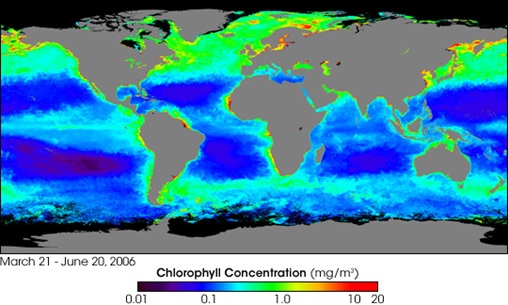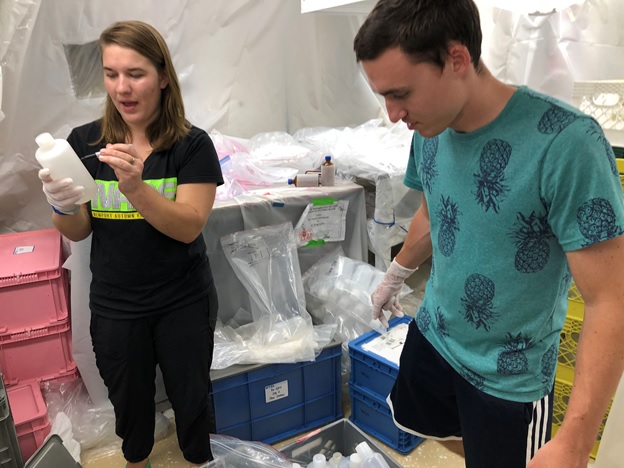The ultimate goal of GEOTRACES and GP15 is to better understand the world’s oceans. But focus only on the edifice of accumulated scientific knowledge that GP15 hopes to produce, and one risks papering over the efforts of the human beings laying the bricks of data.

During GP15’s nearly three-day Super Station at the equator, I followed Laramie Jensen of Texas A&M University and Brent Summers of the University of South Florida, both graduate students in chemical oceanography working as Super Technicians on GP15. “Super Techs,” as they’re called on board, collect and prepare high quality samples for scientists aboard the Roger Revelle and back on land.
Jensen and Summers are integral to the success of GP15, but public recognition of their toil is likely to be relegated to a handful of acknowledgements in the back pages of scientific journals.
The tight schedule of our expedition often forces them to forgo sleep for 24 hours or more, with most of that time spent working together in tight quarters. During GP15 they sleep, eat and work on the same schedule. If I see one of them, I justifiably expect the other to be nearby.

The scale of GP15 and the intensity of activity during its stops to collect data can coalesce into something overwhelming. Much of the data produced by this expedition will take a year or more to analyze and interpret. To say each day’s progress is incremental is an understatement.
Contemplating the immensity of GP15’s 39 stations spread across more than 5,000 miles of ocean becomes a liability when, for Jensen and Summers, the task at hand is to split almost 300 liters of seawater into an array of plastic bottles.
What’s a Super Tech?
Each of the major systems GP15 uses to collect samples has one or two Super Techs. These individuals, usually graduate students, look after the instrument itself and help manage the distribution of the samples it produces.

Jensen and Summers are assigned to the trace metal clean CTD rosette, which, through some linguistic sleight of hand, is abbreviated to GTC by the scientists of GP15. What makes the GTC different from other CTD rosette sampling systems is that it specializes in studying trace metals.
Iron is the prototypical trace metal in the oceans. Like all trace metals, iron is scarce, but some of the world’s most prolific marine ecosystems depend on it. Studying an element present only in tiny quantities means samples can easily become contaminated—especially aboard a metal ship.
Just walking around on deck could track in sample ruining metals. With science that is so sensitive to contamination, every precaution is taken to keep samples free of wayward metals. The GTC is made of plastic, titanium, and powder coated aluminum to ensure that the trace metals in its water samples come from the ocean rather than the instrument.
Super Techs collect water on behalf of all researchers looking for samples from the GTC. Centralizing this responsibility streamlines the process of doling out water, cuts down on miscommunication and limits the number of people touching, and potentially contaminating, samples.
What’s a Super Station?

A station is someplace the Roger Revelle stops to take measurements and collect samples of seawater. Each station splits into individual casts of the five sampling systems on board—each one devised to siphon its own breed of data from the Pacific. The transit of those instruments into the deep and back to the surface splinters further into particular depths where bottles seal in water or pumps filter out particles for study.
Super Stations are GP15’s most intensive sampling efforts. They take 52 hours or more to complete. Super Stations receive this extra attention because of some feature that piques oceanographers’ interest. Often, this means the station coincides with something like a hydrothermal vent or a deep sea trench, or that the same location was sampled by a previous expedition—affording an opportunity to compare measurements.
What this extra intrigue amounts to is spending more time at the station to collect more water and more measurements. Here at Super Station 29 the main attraction is the equator.
What’s super about the equator?
At the equator, the trade winds blowing from the east drag water on the ocean surface west. Just above and below the true equator, the rotation of the Earth produces what’s called the Coriolis Effect. This spins the easterly wind, and the surface water it’s pushing, to the right in the Northern Hemisphere and to the left in the Southern Hemisphere.
A simple way to think about how the Coriolis Effect works is to try to draw a straight line across a spinning piece of paper. The spinning causes a line that would otherwise be straight to curve one way or the other. The direction of the wind’s curve switches depending on the hemisphere in the same way the arc on the spinning paper would if you flipped the paper over. The difference is that the Earth is a sphere so “the other side of the paper” is geographically quite close by.

As the wind pulls surface water away from the equator it is replaced by deeper, nutrient-rich water. This infusion of deep water nutrients is called upwelling and often occurs on the coast. Those nutrients fuel phytoplankton growth which then attracts the whole gamut of ocean life.
This upwelling and the marine life it supports is what makes the equator special for GEOTRACES. “Many of the trace metals and isotopes we are studying on GP15 are tightly coupled with biology,” said Chief Scientist Greg Cutter of Old Dominion University in Norfolk, Virginia. “We are studying the linkage between biology and chemistry in the ocean.”
Prep: November 7
2:30pm
Most of GP15’s science party is catching up on sleep as the Roger Revelle motors south towards the equator. I am on deck with Jensen and Summers preparing for the coming Super Station.
Under the equatorial sun I feel like an ant smoldering beneath a magnifying glass. We make several trips to stow 12 plastic crates in pallet boxes scattered about the ship. Each crate is full of labelled bottles containing the previous station’s seawater samples.

This preparation is not optional. If Jensen and Summers kicked back in between stations, the relentless schedule would bury them like an avalanche upon the Revelle’s arrival. If they fall behind it could delay the entire ship’s scientific operations—and with the ship’s operating costs totaling around $60,000 per day, every second is valuable.
We move inside the ship, clanking shut heavy, metal doors behind us. Jensen and Summers remove their shoes and we pile into an improvised clean room we call the bubble—plastic sheeting covers every surface to keep contamination at bay. The room is small and claustrophobic with three people inside.

Jensen and Summers’ anti-contamination practices make them easy to find, I just look for their abandoned shoes. Summers, 23, has short brown hair and wears black athletic shorts and a turquoise t-shirt covered in pineapples. He is wiry and alert. He laughs easily but carries some kind of tension with him everywhere—perpetually coiled and ready to spring into action. His sense of humor is dry and acerbic, but beneath the stream of baseless insults that keep Jensen and others entertained he is genuine and conscientious.
Jensen, 24, wears black synthetic pants and a black cotton t-shirt. Her brown hair—lighter than Summers’—hangs just past her shoulders. Outwardly, Jensen seems the more relaxed of the pair—sometimes bursting into disconcertingly accurate renditions of bygone pop hits—but she is meticulous. She wears a blue plastic watch on her right wrist that is always timing something—today it has been 17.5 hours since the GTC was last in the water.

They both stand around 5’5 and have oceanic blue eyes—Jensen’s lighter and tropical and Summers’ the darker blue of the North Pacific waters we passed through in late September. It’s not hard to see why they’re sometimes called “the twins.”
The plastic coated bubble appears to contain an unadulterated mess of plastic bags with little open floor space, but the Super Techs flit about easily, stepping in the cracks between crates in their socks.
We finish for the day around 6pm. I tie up some loose ends on the computer and I’m in bed by 11pm. We start work just after 6am tomorrow and from then on we’ll be working or catching our breath for more than 48 hours.
Stay tuned for part 2!
GP15 blog posts written by Alex Fox unless otherwise stated.
Follow GEOTRACES GP15 on WordPress.com

GEOTRACES GP15 is supported by the National Science Foundation. Any opinions, findings and conclusions or recommendations expressed in this material do not necessarily reflect the views of the National Science Foundation.

2 thoughts on “Super Station, Super Techs – Part 1”